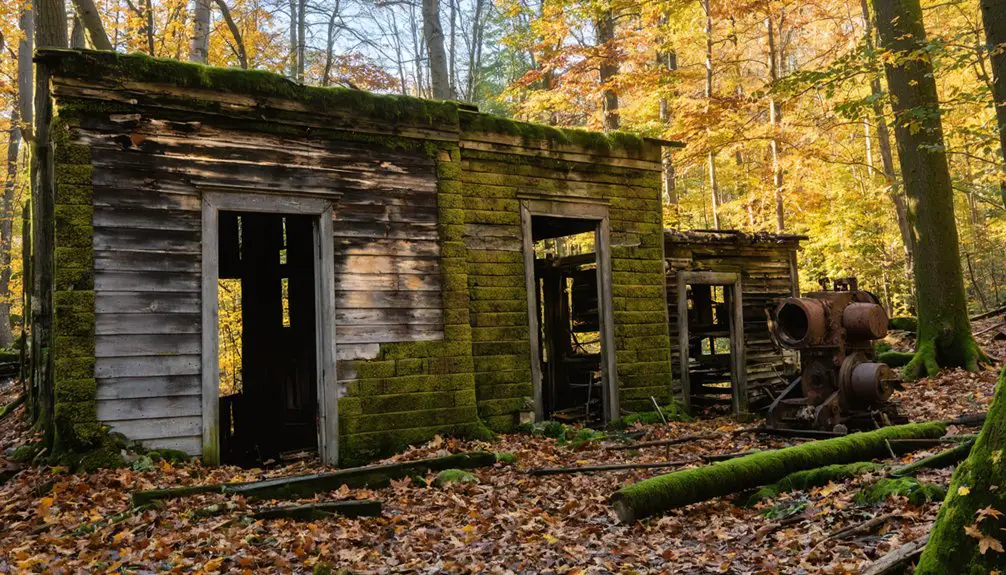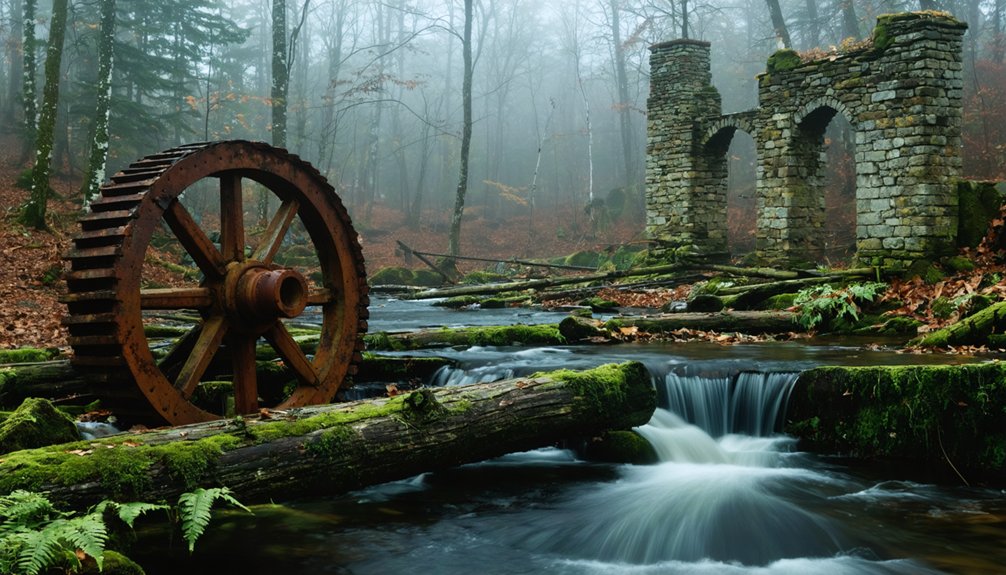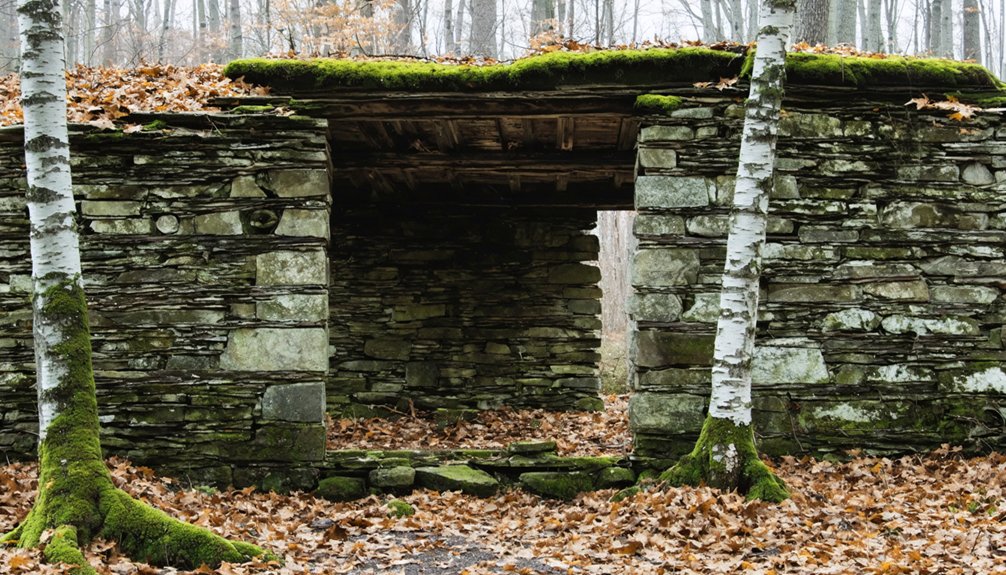You’ll find Livermore’s ghostly remnants in New Hampshire’s White Mountain National Forest, where the Saunders brothers established their lumber empire in 1876. This company town thrived with up to 200 residents during its peak years through 1928, supported by extensive timber operations and mill work. After devastating floods and economic hardship struck, the population dwindled until the town’s abandonment in the 1940s. The ruins along Sawyer River Trail hold countless stories of this once-bustling logging community.
Key Takeaways
- Livermore was a logging town founded in 1876 in New Hampshire’s White Mountain National Forest, now accessible as a ghost town.
- The town reached its peak population of 200 residents between 1876-1928, supported entirely by the Grafton County Lumber Company.
- Devastating floods in the late 1920s led to mill closures and population decline, with most residents leaving by the 1940s.
- Visitors can explore Livermore’s ruins via the 1.5-mile Sawyer River Trail, best accessed during summer and early fall.
- The ghost town’s history is preserved through extensive archives, including photos and artifacts dating back to its 1876 incorporation.
The Rise of a Logging Empire
In 1876, brothers Daniel and Charles Saunders from Lawrence, Massachusetts, founded Livermore as a logging town after investing $150,000 (equivalent to $3.6 million today) into mills and village infrastructure. The town, named after Daniel’s wife Mary Jane Livermore Saunders, quickly established itself as a formidable logging empire through the Grafton County Lumber Company.
You’ll find that their logging techniques revolutionized the area, supported by the strategic construction of the Sawyer River Railroad in 1874.
With extensive timber rights via the Elkins Grant, the company transformed the wilderness into a thriving industrial hub. By 1880, Livermore boasted two mills, 18 homes, and 103 residents. Their sustainable selective cutting methods helped preserve the forest ecosystem while maintaining profitable operations. Sadly, a devastating mill fire in 1919 marked the beginning of the town’s decline.
From untamed forest to bustling industry, Livermore emerged with two mills, multiple homes, and a growing population.
The town’s population would later peak at 200, with most residents working in the lumber industry that Daniel Saunders personally oversaw until his death in 1917.
Life in a Company-Owned Town
You’d find life in Livermore completely controlled by the Grafton County Lumber Company, which owned the housing, utilities, and essential services that residents depended on.
The company’s influence extended into every aspect of daily existence, from your rental agreement tied to employment to the Sawyer River Railroad that transported both lumber and passengers. The rapid population growth led to an expansion from 48 to 200 residents in 1878 alone. For historical clarity, this location should not be confused with other places named Livermore across different regions.
Mill workers and their families formed a tight-knit but dependent community, centered around the lumber operations that provided their livelihood while keeping them economically bound to the company’s success or failure.
Corporate Control Impact
Life in Livermore exemplified the classic company town model, where the Saunders family’s Grafton County Lumber Company controlled nearly every aspect of residents’ daily existence.
Under their corporate governance, you couldn’t own your home, choose your employer, or make independent community decisions. The company dictated everything from housing to communication services. The town’s population grew steadily to reach 200 by 1920.
This economic dependency meant your survival hinged on the company’s success. When disasters struck, like fires or the devastating 1927 flood, you’d watch as the company rebuilt only what served their interests.
The town’s fate was sealed by this rigid control – when lumber prices fell and infrastructure crumbled, there wasn’t enough independent economic strength to sustain the community.
Mill Workers Daily Life
Working at Livermore’s mills meant facing grueling sixteen-hour days that started well before sunrise.
You’d arrive at your machine by 5:00 A.M., managing up to 100 bobbins while dodging flying shuttles in the hazardous environment. The stale, humid air filled with cotton lint made breathing difficult, and you’d struggle to see your work during short winter days when natural light was scarce. Workers suffered from respiratory diseases frequently due to the poor air quality.
After your shift ended at 7:00 P.M., you’d return to a crowded company boarding house, sharing meals and living space with 20 to 30 other workers. Most workers were young farm women who left their family’s agricultural life behind for mill work.
Despite the hardships of mill work, you’d find comfort in community support through shared activities like lectures, reading, and sewing.
Your daily wage of $0.30 provided modest independence after room and board deductions, allowing you to save money or help your family.
The Saunders Family Legacy
The Saunders family’s influence on Livermore, New Hampshire began with their distinguished English heritage dating back to 1637, when their ancestor Tobias Saunders first established the family’s presence in New England.
The Saunders legacy in Livermore traces back to 1637, when Tobias Saunders planted the family’s roots in New England soil.
You’ll find the Saunders heritage deeply woven into Livermore’s fabric through their acquisition of the 80,000-acre Elkins Grant in 1864. The family’s influence expanded when Harvard-educated brothers Daniel and Charles Saunders founded the Grafton County Lumber Company in 1874. Daniel’s role as State Senator of Lawrence added to the family’s political and business prominence in the region.
Their lasting impact on Livermore included:
- Daniel’s role as a prominent resident until his death in 1917
- The construction of the landmark Saunders mansion overlooking the village
- The sisters’ determination to maintain family control by repurchasing the mill’s mortgage in 1919
The Saunders legacy remains evident in Livermore’s history as a reflection of their industrial vision and community leadership. The family’s initial $150,000 investment laid the foundation for what would become a thriving lumber community.
Peak Years and Daily Operations
During Livermore’s peak years between 1876 and 1928, you’d find a bustling logging community of 150-200 residents nestled in New Hampshire’s White Mountains.
Your daily life would revolve around the town’s logging operations, where advanced logging techniques kept the sawmills running at full capacity. Local and traveling lumberjacks worked side by side, processing timber from the surrounding forests.
You’d get your supplies at the company store, send your children to the local school, and rely on the blacksmith to maintain essential logging equipment. The White Mountains location made it an ideal spot for the thriving logging industry.
Community events often centered around the mill’s activities, with the town’s strategic location near Lincoln, Woodstock, and Mount Washington facilitating lumber transport via railroad connections.
The well-organized infrastructure supported both industrial operations and residential needs until flooding in the late 1920s disrupted operations.
Natural Disasters and Economic Decline
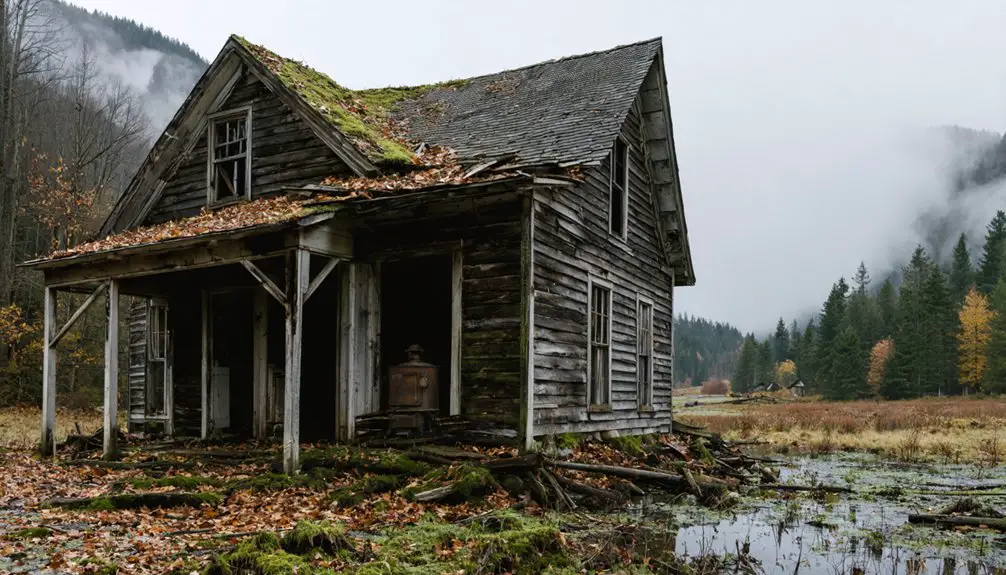
As devastating floods struck Livermore in the late 1920s, they triggered a chain of events that would ultimately seal the town’s fate. The natural disasters damaged critical infrastructure and hastened the closure of all sawmills by 1928, crippling the town’s economic backbone.
The combination of environmental challenges created a perfect storm of economic hardships:
A cascade of ecological crises converged to create devastating financial pressures that would ultimately destroy the town’s economy.
- Extensive deforestation had already weakened the region’s environmental stability.
- Fires destroyed mills and residential buildings, making rebuilding costs prohibitive.
- Floods damaged infrastructure beyond repair, deterring new business investment.
With the Saunders family’s mills shut down, Livermore lost its primary employer. The population dwindled from 200 residents to nearly zero by the late 1940s, as people sought opportunities elsewhere.
The Final Residents
You’ll find that Livermore’s final residents faced increasing isolation as the town’s population dwindled from its peak of 200 to just four or five families by the mid-1940s.
The Saunders family, who’d originally owned much of the town’s infrastructure, were among those who gradually sold their land to the Forest Service throughout the 1930s.
Last Known Inhabitants
The final inhabitants of Livermore represented just a handful of resilient families who remained after the Forest Service acquired most of the town’s land in 1934.
These final families persisted through challenging conditions, maintaining subsistence lifestyles in the remote, forest-encircled community.
By 1949, only four or five families called Livermore home, facing:
- Isolation from civilization with minimal neighbors
- Lack of essential services and infrastructure
- Dependence on dwindling forest resources for survival
Despite occasional census records suggesting later residents, these reports were ultimately confirmed as errors or temporary occupants.
The last true inhabitants departed by the early 1950s, when the town’s unincorporation marked the end of government recognition.
Today, while the Shackford heirs retain a small parcel, the wilderness has reclaimed most traces of human habitation.
Population’s Gradual Exit
Following the devastating flood of the late 1920s, Livermore’s population steadily declined from its peak of 150-200 residents as the town’s economic foundation crumbled. The population dynamics shifted dramatically after the Saunders’ mills closed in 1928, triggering a mass exodus of workers and their families.
Despite early signs of community resilience, you’d have witnessed the town’s slow disintegration through the 1930s and 40s. As essential services disappeared one by one – the school, store, and blacksmith shop – more families chose to leave.
The deteriorating roads and utility infrastructure, combined with the town’s remote location in the White Mountains, made daily life increasingly difficult. Social isolation took its toll on those who remained, and by 1950, Livermore had become virtually abandoned, with only two residents recorded in later censuses.
Exploring the Ghost Town Today
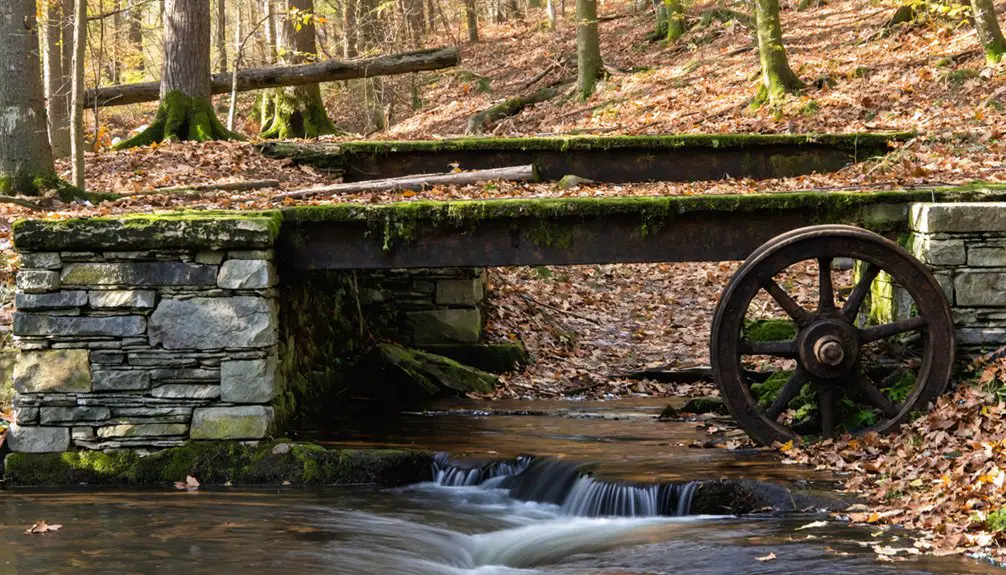
Situated deep within New Hampshire’s White Mountain National Forest, Livermore ghost town welcomes visitors through Sawyer River Road, which divides the abandoned settlement in half.
Nature’s reclamation of this historic site creates ghostly encounters among moss-covered mill remnants and a prominent red brick chimney from the former powerhouse.
To explore Livermore effectively, you’ll want to:
- Park at the Route 302 lot, as road conditions beyond can be challenging
- Follow the moderate 1.5-mile Sawyer River Trail through the wooded ruins
- Allow about two hours to discover stone foundations and surviving apple trees
Summer and early fall offer ideal exploration conditions, though you’ll need sturdy footwear for uneven terrain.
Remember to bring supplies, as there are no active facilities within this hauntingly beautiful monument to industrial decline.
Preserving Livermore’s Memory
While physical remnants of Livermore slowly fade into nature’s embrace, preservation efforts have transformed this ghost town’s legacy into a well-documented historical record.
You’ll find extensive archives dating back to its 1876 incorporation, including photos of the powerhouse, school, and Saunders mansion. Historical documentation continues through maps, artifacts, and contemporary media.
Today, you can explore Livermore’s memory through various channels. Local historians maintain detailed records of the town’s timeline, while educational institutions use it as a case study.
Digital platforms share information about the ruins, and the Sawyer River Trail offers a unique way to experience the site. Though official interpretation is limited, preservation efforts focus on collecting stories and photographs, ensuring future generations can understand this fascinating chapter of New Hampshire’s history.
Frequently Asked Questions
Are There Any Paranormal Activities Reported in Livermore’s Ruins?
You won’t find documented ghost sightings or haunted locations here. While the ruins create an eerie atmosphere, there’s no verified paranormal activity – just the natural spookiness of an abandoned forest town.
What Happened to the Town’s Cemetery and Grave Sites?
Past preservation perished as you’ll find the cemetery succumbed to nature’s takeover. Without grave site maintenance after the 1920s floods, markers vanished beneath vegetation, leaving no visible traces today.
Did Any Movies or TV Shows Feature Livermore’s Ghost Town?
You won’t find any official film references or TV shows featuring this ghost town. While local YouTubers explore its ruins and share ghost stories, no major productions have used the remote location.
Can Visitors Legally Remove Artifacts Found at the Site?
No, you can’t legally remove artifacts. Legal regulations strictly forbid artifact removal without proper permits and landowner permission. Violating these preservation laws could result in criminal charges and hefty fines.
Were There Any Notable Crimes or Mysteries in Livermore’s History?
You won’t find any unsolved disappearances or historical crimes in the records. Research shows the town’s decline was purely economic, with no documented mysteries or criminal activities throughout its existence.
References
- https://wokq.com/ghost-town-of-livermore-new-hampshires-smallest-town/
- https://www.nhmagazine.com/livermore-is-a-strange-name-for-a-ghost-town/
- https://outdoorodyssey.net/2022/11/03/the-haunted-ghost-town-of-livermore-nh/
- https://www.youtube.com/watch?v=mFBYIdURBvQ
- http://people.matinic.us/garrett/teaching/geog-45/fa-17/atlas/places/livermore
- https://www.lancerspiritonline.com/34775/showcase/forgotten-new-hampshire-episode-1-livermore/
- https://www.whitemountainhistory.org/livermore-tripoli-company
- https://www.whitemountainhistory.org/abandoned-towns/livermore
- https://www.bartletthistory.net/livermore-timeline
- https://en.wikipedia.org/wiki/Livermore
